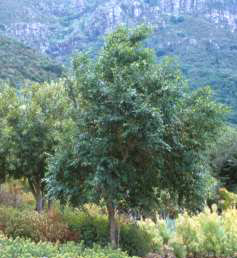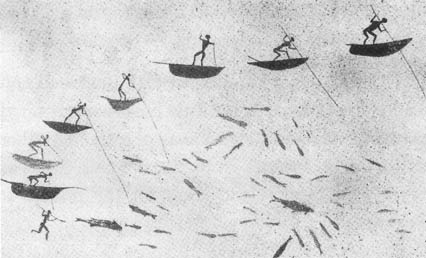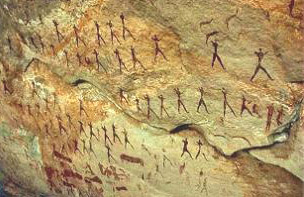


© Underberg Accommodation - 2016
HOME PAGE

San Rock Art
One hundred years ago the wide rolling upland of the Underberg plateau was lush grassland. On the rocky hillsides there were beautiful shrubs amongst the boulders such as Bladdernut or Wild coffee and in Zulu, umTenatane, the Tree Fuchsia or in Zulu, umBinza and Watsonias.
Among the boulders and ridges had been lookouts and workshops for the Bushman. There were flakes littered around anvil boulders where they had chipped at their arrowheads and scrapers. Many of the Bushman paintings were still fresh, bright, and topical, with scenes of wagons and horsemen with their guns. The Bushman had not been gone for long and there would have been some Bushmen still around in the late 1880's.
One hundred years ago the wide rolling upland of the Underberg plateau was lush grassland. On the rocky hillsides there were beautiful shrubs amongst the boulders such as Bladdernut or Wild coffee and in Zulu, umTenatane, the Tree Fuchsia or in Zulu, umBinza and Watsonias.
Among the boulders and ridges had been lookouts and workshops for the Bushman. There were flakes littered around anvil boulders where they had chipped at their arrowheads and scrapers. Many of the Bushman paintings were still fresh, bright, and topical, with scenes of wagons and horsemen with their guns. The Bushman had not been gone for long and there would have been some Bushmen still around in the late 1880's.
A Tree Fuchsia

A drawing of a Bushmen painting - drawn in the late 1800's


Trooper Alistair Douglas Whyte, of the Natal Mounted Police, who in 1907 spent four months gathering material on the local rock art.
The Bushmen followed the seasons and migrations of game over thousands of years, living in harmony with nature and leaving no trace of their presence other than these remarkable stories on the walls of their rock shelters.
The mysterious techniques of how the paintings were created, their symbolism and also interpretation, have been the subject of much debate.
What is very clear is the deeply spiritual significance these paintings represent for the Bushmen. We can get a glimpse of their way of life, the animals they encountered and their spiritual activities.
The mysterious techniques of how the paintings were created, their symbolism and also interpretation, have been the subject of much debate.
What is very clear is the deeply spiritual significance these paintings represent for the Bushmen. We can get a glimpse of their way of life, the animals they encountered and their spiritual activities.
The Bushmen painted was rock on a type of rock, which was porous enough to absorb the pigment but smooth enough to work upon.
It is said that the red pigment was made from red ochre mixed with various other iron oxides – haematite, which was heated and then ground into a fine powder.
Black was made from the charcoal of burnt sticks and white was a mixture of clay and plant sap, however berries, bone marrow, blood, animal fat, roots and soil were also used.
Yellows and other earthy colours can be found in sedimentary stones cracked in half and rubbed together giving off a fine powder and then mixed with animal fat to make a light coloured paste. The rock painters were truly talented, using whatever they had around them to create such wonderful works of art.
It is said that the red pigment was made from red ochre mixed with various other iron oxides – haematite, which was heated and then ground into a fine powder.
Black was made from the charcoal of burnt sticks and white was a mixture of clay and plant sap, however berries, bone marrow, blood, animal fat, roots and soil were also used.
Yellows and other earthy colours can be found in sedimentary stones cracked in half and rubbed together giving off a fine powder and then mixed with animal fat to make a light coloured paste. The rock painters were truly talented, using whatever they had around them to create such wonderful works of art.
The uKhahlamba Drakensberg World Heritage site contains 500 known sites of San rock art, with over 40 000 images.
Nomadic Bushmen had roamed the high Underberg plateau from time immemorial. For at least seven thousand years 'Good Hope Shelter' near the Sani Pass Hotel was used, probably with seasonal migrations towards the coast to `Umbelli-belli Shelter', up-river from Scottburgh. Our plateau was inhospitable to Bantu with a dearth of firewood and hut-building material, a short crop-growing season and no winter grazing.
Nonetheless a symbiosis between Bushman and Bantu was fostered by the Zulu kings who required of Bantu communities tributes of otter and other skins, crane feathers from the uplands (used as regimental regalia) and ivory for the traders at Port Natal.
A highly significant personality in the south-west corner of Natal in the mid 1800's was Dumisa ka Mvenya, born circa 1800. It is quite probable that during his youth in the upper Mkhomazi valley he was closely associated with Bushmen after his own people had been put to flight and their kraals sacked during the Tshakan era.
The Bushmen taught Dumisa how to hunt elephant using poisoned spears. This was at a time when fugitive Bantu had no fixed abode, but lived `under the stars', scavenging and hunting. Dumisa's prowess as a provider of meat earned him a following. As a new tribe they settled near Mzinto where Dumisa was officially.recognised as a chief by the colonial authorities.
Nonetheless a symbiosis between Bushman and Bantu was fostered by the Zulu kings who required of Bantu communities tributes of otter and other skins, crane feathers from the uplands (used as regimental regalia) and ivory for the traders at Port Natal.
A highly significant personality in the south-west corner of Natal in the mid 1800's was Dumisa ka Mvenya, born circa 1800. It is quite probable that during his youth in the upper Mkhomazi valley he was closely associated with Bushmen after his own people had been put to flight and their kraals sacked during the Tshakan era.
The Bushmen taught Dumisa how to hunt elephant using poisoned spears. This was at a time when fugitive Bantu had no fixed abode, but lived `under the stars', scavenging and hunting. Dumisa's prowess as a provider of meat earned him a following. As a new tribe they settled near Mzinto where Dumisa was officially.recognised as a chief by the colonial authorities.

Certain scenes depict what appears to be communion with the spirit world - the transitional experience brought about through trance dance and ceremony. Certain animals were special to the Bushmen, in particular the Eland, which is shown as a power figure. Pre-historic rock art in South Africa has been dated back to thousands of years ago, which means that the Bushmen people roamed the land over a great age, their ways relatively unchanged until the settlers arrived.




- BED & BREAKFAST
- SELF CATERING
- HOTELS
- BACKPACKERS
- CAMPING
